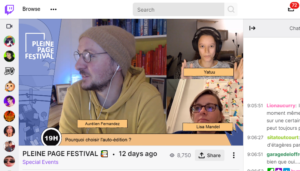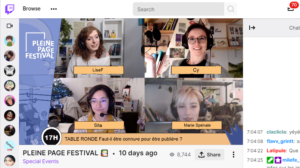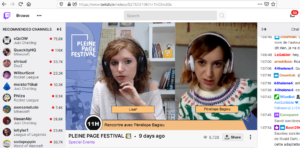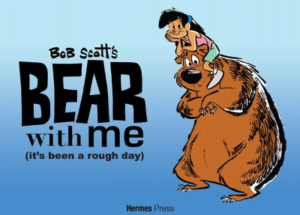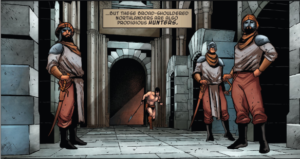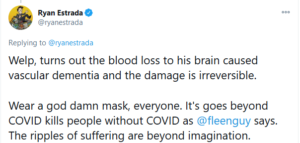Self Publishing: Same Issues In Any Language
Fleen Senior French Correspondent Pierre Lebeaupin continues his recaps of the Pleine Page Festival, this time with a panel discussion from the festival co-host. I’ll note that this is the third 2200+ word piece you’ve gotten this week, because that’s how we do things at Fleen: news from around the world from people on the ground, not the same old cape comic press releases.
The panel discussion Why Choose Self-Publishing?, moderated by festival co-host Aurélien Fernandez¹, began with an introduction of the panelists and their own crowdfunded projects: Yatuu switched to crowdfunding after working with various publishers, with 5000 books preordered for her latest campaign, up from 2800. Lisa Mandel produced various works with various publishers before running Une Année Exemplaire first on Instagram, then funding a print run for it with a crowdfunding campaign.
Mandel: She launched it on a hunch; at the time her blog on the website of Le Monde has stopped, as well as her own blog, and she had few Instagram followers. So in the end she got sufficient funding, but no further, from the crowdfunding campaign proper (about 550 books, which amounts to about 15,000€) [Author’s note: her campaign completely flew under my radar at the time, though my radar could always stand improvement anyway]. She later did a post-campaign preorder offer about 4-5 months ago, which doubled the preordered amount, and later on her selection for Angoulême netted her additional sales. Her participation in the Exemplaire project was a long time coming, they even intend not to contract with a distributor so as to get experience themselves with all the parts of the book value-adding process.
Fernandez: They both have experience with the traditional publishing system, why self-publish then?
Yatuu: First issue: she did have interested publishers, but they only agreed to a single book … which wasn’t compatible with the worldbuilding she intended to develop; none of them wanted to take a risk on a book series. And even if she could sign with a cooperative publisher, he could later change his mind and not fund the following book, which wasn’t acceptable to her.
Second issue: the financials, as she intended to live off making comics, while before she had to alternate that with freelance illustration work, due to weak advances. As for royalties, the percentages are so slim she doesn’t start earning out until many books have been sold, so in the end it was too difficult for her to make a living on comics.
Mandel: More or less the same reasons for her, first as an experiment as she was comfortable with her situation and had a 17-year career behind her. She started with Nini Patalo in 2000, and by 2003 the golden era was coming to an end: she was earning 15000€ advances per book, or 300€ per page before taxes, but half of that was funded by the book being first published in a comics magazine found in newsstands, which no longer exists.
It went downhill from there, as when she proposed doing a 6th book, her publisher attempted Wouldn’t you want to earn less than 17 years ago?: between the increased cost of living and her carrier progression, that was unacceptable, and she had to negotiate to merely track inflation.
She has seen everything: in her late teens manga was still unknown except for heavyweights like Dragon Ball, now the market is saturated even if it is not necessarily with bad works. Now, she’s currently on contracts allowing her to make a decent living, but solely off advances for books which never earn out. And she realized that she had no coverage for holidays, unemployment, etc. Which resulted in her never taking a break to assess her situation.
Fernandez: Don’t the creators rely less and less on royalties these days anyway?
Mandel: She still did so at the time of the first Nini Patalo book, and while she is not in the same situation as Yatuu, she’s been chomping at the bit² for the last 20 years on the contracts she is being proposed being warped (with the notable exception of L’Association, which have always been transparent with her).
She mentions publishers acting in bad faith: tying the audiovisual rights, attempting to introduce abusive clauses and when called on it, pretending we’re not going to exercise it, and for instance on a series the contract did commit the creator to three books, but did not similarly commit them to publish these same three books. She is sick and tired of having to double-check her contracts because of dishonest publishers who seem to think they’re a creator, they did not study business administration.
Yatuu: She’s a dummy when it comes to negotiation, she signed her first contract blind, trusting the publisher, then for her second she sough the help of the SNAC [Author’s note: a trade union of comics creators], which she was right to so: she was proposed a contract meant for a prose book.
Mandel: Even if there is a need for creators to take some responsibility, the publishers end up abusing their legitimate trust, they play on the partnership and the emotional relationship even though creators are in practice in the weaker position.
Fernandez: He did read in the Racine report that many creators coming to comics from other fields don’t know how to defend the creation side, and end up with too little money to share.
Mandel: Even as a lineup lead, she is barred from discussing payment with creators. She’s unhappy with any situation where two fellow creators don’t earn the same from the same publisher, just because one of them can negotiate; she had to learn that on her own, not in art school.
Fernandez: The Twitch commenters agree such a thing is missing from art school curriculum.
Mandel: What kind of art school can pretend to prepare their students to this field without touching on such matters? This is part of the job, it’s not all just artistry. She denounces the favors being made to creators who don’t sell all that much but are prestigious to feature in the publisher’s catalog, and as a result get better advances and get better promo, to the detriment of others.
Fernandez: On the matter of promotion, isn’t the creator’s presence on social networks watched by publishers?
Mandel: You know the answer. (Fernandez: Yes, but the audience does not.) Of course, creators enjoying success on social networks are hired by publishers, but get offered stinky advances and poor conditions, on the pretense that they’re starting out and their audience does not necessarily translate to sales. Except that may not be a fair assessment of the market, so publishers pick and choose from that pool and freely use the marketing done by the creator while they should be paying these creators in accordance with the promotion these creators do by themselves.
Fernandez: Erika And The Princes In Distress started on Yatuu’s blog.
Yatuu: Her first published book started on her blog already, and led her to receive offers from publishers (it was on overworked trainees in the advertising industry). The promotional work was done already as a result, and yet since she was naive about the whole thing she signed away her rights for a pittance (8000€).
Mandel: Right away she started with multiple publishers by happenstance, so she avoided the whole being emotionally blackmailed by a publisher pretending to be family, and therefore finds it absurd to fear presenting a project to other publishers just because you already have a relationship with one. There can be a contract clause for that [Author’s note: which would be known as right of first refusal in English-speaking countries].
Fernandez: Which can be justified for further books in a series, but not in general. In fact this doesn’t bother anybody: editors know one another, even in different houses. Let us move on: what kind of workload does the entail, what kind of support do platforms provide?
Yatuu: She’s got a contact assigned to her who gives her feedback on the campaign, introduces her to suppliers, so she’s not being left to fend for herself even if creators do most of the job. The workload is huge, in non-obvious ways. For the second book, she’s planning for a May release, and she has a full schedule until then: book layout, suppliers, print run sizing, color matching: all the work performed by a publisher lands on her lap. She gets some followup from Ulule.
Fernandez: Does this mean 3000 books end up in your living room?
Yatuu: Ah, storage. Her boyfriend’s parents have a big garage which they can use to store the multiple pallets of books which are going to arrive, which amount to more than just the preordered books. She gets a lot of help from Brice, the boyfriend –he handles book layout, printer interactions, suppliers, logistical issues such as amounts ordered, etc. The workload is so huge she wouldn’t have done so without him; there would be too many roles to play.
Mandel: When she revealed her intents she was warned many times: Fly, you fool!
Fernandez: So it’s not just for upstarts intent on staining the beaten pulp of dead trees, but also in case you want an out on the system.
Mandel: It’s impossible to do everything yourself unless you want to sleep 2 hours per night, so she sought help: on paper type, on printer quotes; then she was able to have the books delivered at the studio, so she hired people to package them: she already had 1000 preorders to fulfill, on top of day-to-day sales, not to mention customer service — people who moved without telling, but also those who did but weren’t taken into account because the address label was printed too early, packages lost en route.
So she hired her sister as her own Brice-alike, her sister handles distribution in particular as that is an important source of interruptions: logistical issues unrelated to her artistic activities would otherwise interrupt her every hour or so, and prevent her from focusing on her drawing.
Yatuu: You have to accept having less time available to draw.
Mandel: It can be good to take a break from drawing, but it is time-consuming, so don’t expect being able to start drawing your next book right after completing the previous one.
Fernandez: Which leads us to the Exemplaire project.
Mandel: Indeed, she has confirmed from experience that it was possible and even profitable, but not possible by yourself, so might as well set up a mutualized structure. So rather than have all the risk taken up by the publisher, and badly paid creators, have a structure that does not take on debt, and relies on crowdfunding instead.
Fernandez: What is the legal status of the entity, how different is it actually from a publisher?
Mandel: It will be a S.A.S. [Author’s note: I am not remotely competent enough to provide a U.S. equivalent, if there even is, all I know is that is is a kind of incorporation³] with other associates later, for now herself with a software engineer. The principle is that the creator does his own marketing, and need to take on some other publisher responsibilities, such as storage; then, he chooses what kind of further implication he takes on: if he does only that minimum, he gets 30%.
Capitalization is reduced to a minimum: the earnings from a successful book are not retained to later fund unrelated ones. There will be no salaries: everyone is paid a portion of sales including non-creators (book layout, etc.). And obviously no printing if the crowdfunding for the book fails. They do consider distributing to bookshops.
At this point Fernandez fetched question from the chat log:
- What is Yatuu’s work relationship with Brice?
Yatuu: He has a job of his own, and help in his spare time. It was complicated for the first book as he had a day job in an agency, so he could only help on evenings and weekends, now he works as a freelancer, as a result it works better for his time management. He is head of the legal structure they set up, which allows him to charge promo-related expenses (such as when coming to a festival) to that structure. They found an accountant which helped them set that up, which Mandel now hired as well.
Mandel: That greatly helped making the project viable: Get an accountant involved right away.
Fernandez: So emancipation involves someone with a law training.
Mandel: Books earnings go to hiring someone who enables that. Since they’re creating this structure (Fernandez: … of which he is part …) she would like to hire her sister to be a chaperone in attending to the authors who self-publish, however she made her girlfriend work for free.
- What status must be adopted for self-publishing?
Yatuu: I had to create a S.A.S., no choice, in order to receive the crowdfunding money without running afoul of the taxman.
Mandel: Even if a recently passed bill should allow receiving crowdfunding money and self-publishing while keeping your artist-author status.
- Can you embark on self-publishing right out of art school without a community?
Yatuu: Try to make your own place on the Internet first. With an Ulule campaign right away, you risk having no pledges. First build a solid base, even if small in numbers.
Fernandez: Traditionally self-publishing was used when making fanzines or badly bound books; now Instagram has replaced that.
Yatuu: Indeed, and she would suggest getting into it sooner rather than later before it becomes completely like Facebook.
Mandel: First create your space on social networks where you can serialize, then build a small community and you can consider launching a crowdfunding campaign: friends and family are insufficient when crowdfunding.
Fernandez: Any last word?
Mandel: It’s good that this exists, and if that could lead everyone in the traditional book value-adding process to rethink their role, that would be great; they’re not out to kill publishers.
Yatuu: Exactly: they’re not against them, rather using an alternative. Both work, everyone can make their own choice.
Mandel concluded by encouraging everyone to support the (then-ongoing) Exemplaire crowdfunding project.
Come back for a rare late-pandemic Friday post, as we continue with the news from PPF.
Spam of the day:
The 3 best NUTS that shrink your swollen prostate and boost testosterone
I’m sure that the nuts = testicles thing is a complete coincidence.
_______________
¹ Editor’s note: This session took place a full nine hours into the Twitchstream, and also Fernandez is the first dude we’ve seen in FSFCPL’s writeups. As here in the States, definitely the future French comics and likely the present belongs to women.
² Editor’s note: Confidential to Brad Guigar — in French, the word is chomping, not champing, so put away your righteous fury.
³ Editor’s note: apparently, it’s similar to a British limited company or a US LLC; Wikipedia says the Delaware LLC was the model, and uniquely in French law, it’s based on common law principles rather than civil law. Neat!
